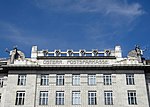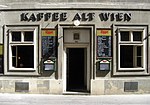Dominican Church, Vienna
1634 establishments in the Habsburg monarchy17th-century establishments in AustriaBasilica churches in AustriaDominican churchesRoman Catholic church buildings in the Vicariate of Vienna City ... and 2 more
Roman Catholic churches completed in 1634Vague or ambiguous time from February 2016

The Dominican Church (German: Dominikanerkirche), also known as the Church of St. Maria Rotunda, is an early Baroque parish church and minor basilica in the historic center of Vienna, Austria. It is the third church built on the same site in the course of time.
Excerpt from the Wikipedia article Dominican Church, Vienna (License: CC BY-SA 3.0, Authors, Images).Dominican Church, Vienna
Postgasse, Vienna Innere Stadt
Geographical coordinates (GPS) Address External links Nearby Places Show on map
Geographical coordinates (GPS)
| Latitude | Longitude |
|---|---|
| N 48.2088 ° | E 16.3788 ° |
Address
Dominikanerkirche (Sancta Maria Rotunda)
Postgasse 4
1010 Vienna, Innere Stadt
Austria
Open on Google Maps









